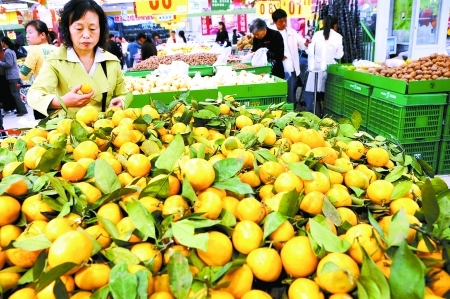Only 12 tons of oranges were destroyed and less than 10 percent of the trees were damaged by fruit flies in Guangyuan, Sichuan province, the provincial agriculture department said on Tuesday.
It was discounting reports that 10,000 tons of oranges had to be destroyed.
|

|
|
People buy oranges in a fruit market in Zhengzhou, cental China's Henan Province, on October 22, 2008. |
On Monday, the Chengdu-based Huaxi Metropolis Daily reported that the local government paid growers 3 million yuan (US$44,000) to purchase the oranges so that they could be destroyed.
The news caused concern among some consumers in Chongqing and Taiyuan, Shanxi province.
Both cities import oranges from Sichuan.
"Orange-growing is a key source of income for farmers in Sichuan. The report of fruit flies can do serious damage," Mou Jinyi, chief agronomist of the agriculture department, said at a press conference in Chengdu.
He said fruit flies of the tetradacu species had been discovered in 11 towns in Wangcang, a county under the administration of Guangyuan.
The agriculture department said only 68,000 trees, accounting for 8.9 percent of the county's total, had been infected and the situation was now under control.
"All oranges were plucked from the damaged trees and buried deeply. The surface was covered with lime to ensure safety," Yang Liu, chief agronomist of the Guangyuan bureau of agriculture, told China Daily.
"The Guangyuan government paid orange farmers 36,000 yuan for their loss," he said.
Postings on the Internet said the sudden appearance of tetradacu flies in Wangcang was due to climate change.
"The flies are not a new pest, and it exists in many provinces. They only do harm to orange trees and not humans," Wan Fanghao, chief scientist at the Biological Invasion Research Office, said.
Wangcang is not very suitable for orange growth, and the county government has been pressing farmers to plant tea instead.
In Chengdu, consumers remained calm.
"I know of the tetradacu outbreak. But I still buy oranges because almost all are from the city's suburbs," Sun Ping, a resident, said.
(China Daily October 23, 2008)